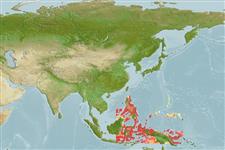>
Gobiiformes (Gobies) >
Gobiidae (Gobies) > Gobiinae
Etymology: Trimma: Greek, trimma, -atos = something crushed (Ref. 45335); trioculatum: Name derived from 'tri' for three and 'oculatus' for having eyes; referring to the extra apparent eye formed by the dark ocellated spot in the first dorsal fin.
Environment: milieu / climate zone / depth range / distribution range
экология
морской ассоциированный с рифами; пределы глубины 5 - 71 m (Ref. 102609). Tropical; 20°N - 9°S, 114°E - 154°E
Western Pacific: known with certainty from Indonesia. Non-types collected from Palau, Papua New Guinea and the Philippines.
Size / Вес / Возраст
Maturity: Lm ? range ? - ? cm
Max length : 1.9 cm SL самец/пол неопределен; (Ref. 102609); 1.7 cm SL (female)
Краткое описание
определительные ключи | морфология | морфометрия
колючие лучи спинного плавника (общее число) : 7; членистые (мягкие) лучи спинного плавника (общее число) : 8 - 9; колючие лучи анального плавника: 1; членистые (мягкие) лучи анального плавника: 8. This species is distinguished by the following characters: first dorsal fin with a large (slightly greater than pupil diameter in width) round, black, ocellated spot in between spines 1 and 5; a second, much smaller black or dark red spot just posterior to the spine of the second dorsal fin and above the basal stripe; body yellow with a dark purplish or gray head with two distinct red bars across the cheek; without round spots of any colour on the nape, opercle or cheek; upper pectoral fin base with a small dark (preserved) or white (alive) spot; a narrow bony interorbital (<70% pupil diameter); first dorsal fin without elongated spines; pectoral fin rays 15-16, with the middle 4-8 rays branched; fifth pelvic fin ray with a single dichotomous branch; total gill rakers on the first gill arch 16-17 (Ref. 102609).
Inhabits steep outer reef walls, often present in groups of up to 20 individuals which are loosely aggregated and perched vertically on the substrate at the back of small overhangs and crevices. Non-type specimens collected were also nearly always found on steep outer reef walls (Ref. 102609).
Life cycle and mating behavior
половая зрелость | размножение | нерест | икра | Fecundity | личинки
Winterbottom, R., M.V. Erdmann and N.K.D. Cahyani, 2015. New species of Trimma (Actinopterygii, Gobiidae) from Indonesia, with comments on head papillae nomenclature. Zootaxa 3973(2):201-226. (Ref. 102609)
Статус Красного Списка МСОП (Ref. 130435: Version 2024-2)
Угроза для людей
Harmless
Использование человеком
рыболовство: интереса не представляет
дополнительная информация
инструменты
Специальные отчеты
Скачать в формате XML
ресурсы в Интернет
Estimates based on models
Preferred temperature (Ref.
123201): 28 - 29.1, mean 28.6 °C (based on 68 cells).
Phylogenetic diversity index (Ref.
82804): PD
50 = 0.5000 [Uniqueness, from 0.5 = low to 2.0 = high].
Bayesian length-weight: a=0.00724 (0.00339 - 0.01546), b=3.10 (2.92 - 3.28), in cm total length, based on LWR estimates for this (Sub)family-body shape (Ref.
93245).
устойчивость к внешним воздействиям (Ref.
120179): высокий, минимальное время удвоения популяции до 15 месяцев (Preliminary K or Fecundity.).
Fishing Vulnerability (Ref.
59153): Low vulnerability (10 of 100).
